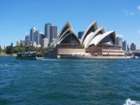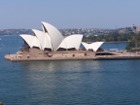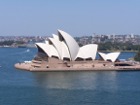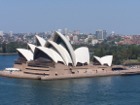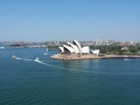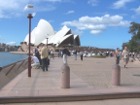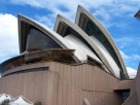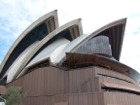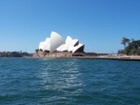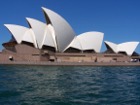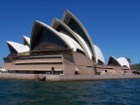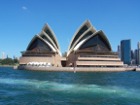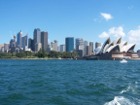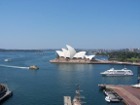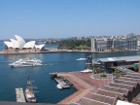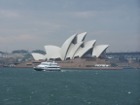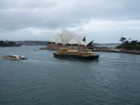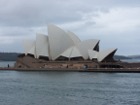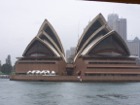Sydney Opera House Photographs
Home > Australian Photos > Sydney Opera House
(Click on an image to view a Larger Picture)
- These images are protected by copyright. They may not be copied for use elsewhere.
- I used a Kodak DX6490 4.0 mega pixel digital camera to photograph these images.
Sydney Opera House
From Wikipedia, the free encyclopedia
The Sydney Opera House in Sydney, New South Wales, Australia, is one of the most distinctive and famous 20th-century buildings, and one of the most famous performing arts venues in the world.
Situated on Bennelong Point in Sydney Harbour, with parkland to its south and close to the enormous Sydney Harbour Bridge, the building and its surroundings form an iconic Australian image. To some the spherical-sectioned shells remind them of the flotilla of sailboats commonly cruising there. Tourists, most with no interest in opera, throng to the building in their thousands purely to see it.
As well as many touring theatre, ballet, and musical productions the Opera House is the home of Opera Australia, the Sydney Theatre Company and the Sydney Symphony Orchestra. It is administered by the Opera House Trust, under the New South Wales (NSW) Ministry of the Arts.
Description
The Opera House covers 1.8 hectares (4.5 acres) of land and offers 4.5 hectares (11 acres) of usable office space. It is 183 metres (600 feet) tall and about 120 metres (388 feet) wide at its widest point. It is supported on 580 concrete piers sunk up to 25 metres below sea level. Its power supply is equivalent for a town of 25,000 people. The power is distributed by 645 kilometres of electrical cable.
It has about 1000 rooms. It has five theatres, five rehearsal studios, four restaurants, six bars and numerous souvenir shops.
The opera house's roof is constructed of 1,056,000 glazed white granite tiles imported from Sweden. Despite their self-cleaning nature, they are still subject to maintenance and replacement. Its interior is composed of pink granite mined from Tarama, NSW and white birch and brush box plywood supplied from northern NSW.
Its five theatres are the Concert Hall (with a seating capacity of 2679), Opera Theatre (1547 seats) , Drama Theatre (544 seats), Playhouse (398 seats) and Studio Theatre (364 seats).
History
The Opera House can be said to have had its beginnings during the late 1940s in the actions of Eugene Goossens, the Director of the NSW State Conservatorium of Music at the time, who lobbied to have a suitable venue for large theatrical productions built. At the time, the normal venue for such productions was the Sydney Town Hall, but this venue was simply not large enough. By 1954, he succeeded in gaining the support of NSW Premier Joe Cahill, who called for designs for an opera house.
It was also Goossens who insisted that Bennelong Point be the site for the Opera House. Cahill had wanted it to be on or near the Wynyard Railway Station, located in the north-western Sydney CBD.
The competition that Cahill organised received over 230 entries. The basic design that was finally accepted in 1955 was submitted by Jørn Utzon, a Danish architect. Utzon arrived in Sydney in 1957 to help supervise the project.
The Bennelong Point Tram Depot, present on the site at the time, was demolished in 1958, and formal construction of the Opera House began in March, 1959. The project was in three stages. The first stage (1959-1963) consisted of building the upper podium; the second stage (1963-1967) was building the outer shells and the third stage was the interior design and construction(1967-73).
The project was riddled with often interrelated problems such as the complexity of erecting the building's overlapping spherical sections, a premature start, sudden changes in building requirements such as an increase from two to four theatres, political complications including a change of Government, financial blowouts (the final bill came to $102 million) and disagreements over internal design. It was formally completed in 1973.
Utzon never saw the completed work after disputes with the then recently elected Askin Government, and in particular, its Public Works Minister, Davis Hughes. Utzon was forced to resign in 1966, during the second stage of construction, and his place was largely taken over by Peter Hall. Utzon left Australia and never returned. It was Hall who was largely responsible for the interior design. Other persons appointed that same year to replace Utzon were E.H.Farmer as government architect, D.S.Littlemore and Lionel Todd.
Prior to the opening, two performances took place there. On September 28, 1973, a performance of Sergei Prokofiev's War and Peace was played at the Opera Theatre. On September 29, the first public concert in the Concert Hall took place. It was performed by the Sydney Symphony Orchestra, conducted by Charles Mackerras and with accompanying singer Birgit Nilsson.
The Opera House was formally opened by Queen Elizabeth II on October 20, 1973. The opening was televised and included fireworks and a performance of Beethoven's Symphony No. 9.
In 1975, its substantial construction bill was finally paid off, mainly through a public lottery system.
It has been subject to some additions and improvements since its opening. Its Concert Hall had a pipe organ , with 10500 pipes, added to it in 1979. In 1988, a two-level walkway along the western side of Bennelong Point was added as part of Australia's bicentenary celebrations. In 1999, a fifth theatre, the Playhouse, was added to the Opera House.
In 1997, French urban climber, Alain "Spiderman" Robert, using only his bare hands and feet and with no safety devices of any kind, scaled the building's exterior wall all the way to the top.
It received attention during Sydney 2000 Olympics. It was included in the Olympic Torch route to the Olympic stadium, and involved Australian swimmer Samantha Riley standing on top of the Opera House waving the Olympic torch. It was the backdrop of some Olympic events, including the triathlon—which began at the Opera House—and the yachting events on Sydney Harbour.
Security at the Opera House has increased as the result of the likelihood of it attracting attention of terrorists because the Australian Government's support of the invasion of Iraq. This security did not prevent two climbers painting a "No War" slogan at the top of one sail in March 2003. The repair bill for this was later revealed to be over $100,000.
Following an arrangement made in 1999, plans are now underway to change Hall's internal design of the Opera House to that of Utzon's. The redesign will involve the house's reception hall and opera theatre , and will be supervised by Utzon. As Utzon is too old to travel by plane, he will undertake the supervision from his home in Majorca. Allowances will be made for modern day technology and requirements. In September 2004, the redesign of the Reception Hall of the opera house was completed.



